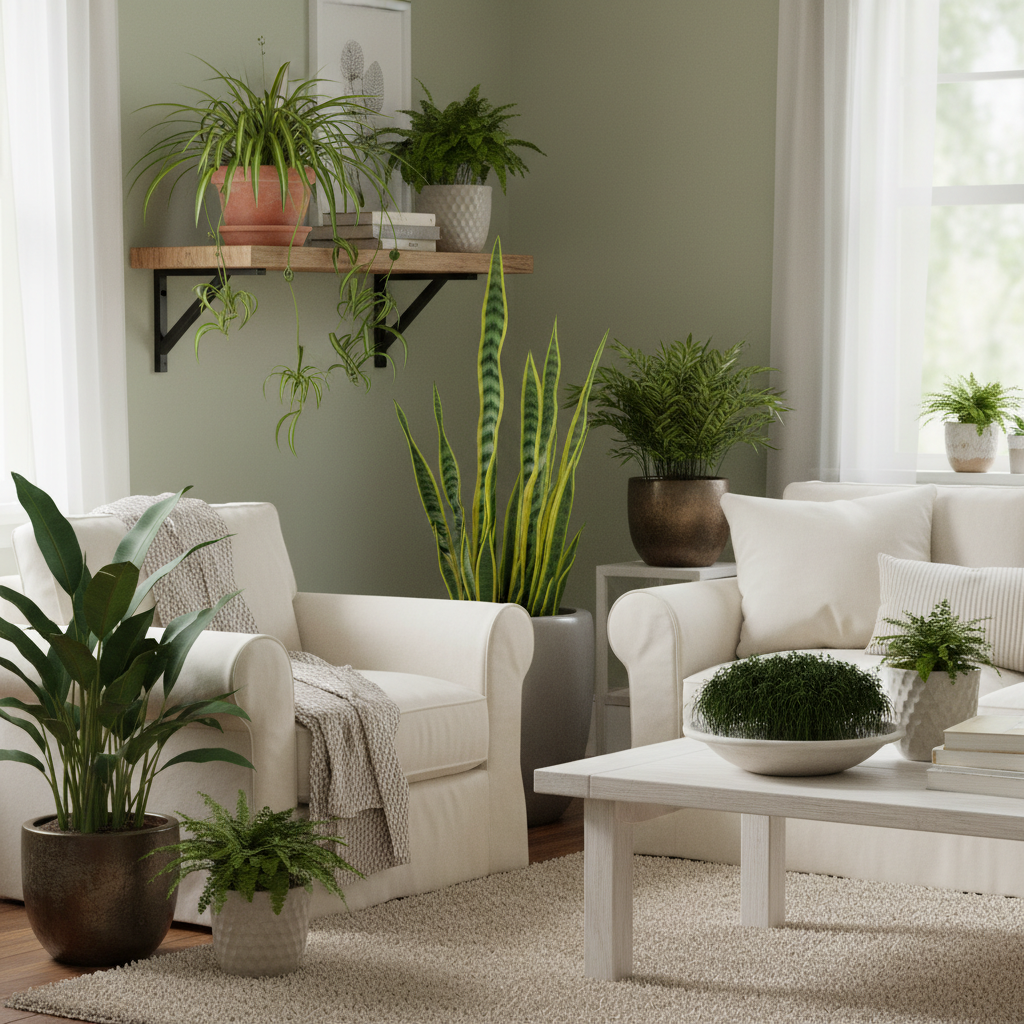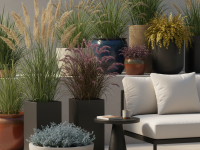Ever dreamed of a lush, vibrant indoor space, but found yourself stumped by limited natural light? You’re not alone! Many homes and apartments, especially in urban areas, simply don’t get enough bright sunshine to keep most houseplants happy. But what if we told you that you could still bring that fresh, natural, green aesthetic into your home, even in those shadowy corners? It’s entirely possible, and easier than you might think!
The secret lies in selecting the right plants. Forget about those sun-loving tropicals; we’re talking about a special category: the best grass-like plants for low light indoor decoration. These botanical gems offer the elegant, linear beauty of ornamental grasses without demanding a spot by the brightest window. They’re perfect for adding texture, softness, and a touch of wildness to your interior, creating a tranquil oasis that feels effortlessly stylish.
In this comprehensive guide, we’ll dive deep into the world of resilient, low-light-loving, grass-like houseplants. We’ll cover everything from what makes a plant “grass-like” to detailed care instructions, creative styling tips, and the many benefits these plants bring to your home. Get ready to transform your dimly lit rooms into flourishing, green sanctuaries!
Understanding “Low Light” for Indoor Plants
Before we jump into our top picks, let’s clarify what “low light” actually means for houseplants. It’s not about total darkness, but rather an area that receives indirect or diffused light for only a few hours a day. Think about these scenarios:
- North-facing windows: These typically offer the lowest intensity of light throughout the day.
- Rooms with small windows: Especially if they’re obstructed by buildings or trees.
- Corners far from any window: The light diminishes significantly as you move away from the light source.
- Spaces under stairwells or in hallways: Often have minimal natural light.
Many plants that thrive in these conditions are originally understory plants in their natural habitats, meaning they grow beneath the canopy of larger trees and are accustomed to filtered sunlight. Our chosen grass-like plants fit this bill perfectly, making them ideal companions for those challenging spots in your home.
Why Choose Grass-Like Plants for Indoor Decor?
Beyond their low-light tolerance, grass-like plants offer a unique set of advantages that make them a fantastic choice for indoor decoration:
- Texture and Movement: Their slender, often arching or upright blades provide a dynamic visual texture that can soften harsh lines and add a sense of fluidity to your decor.
- Modern Aesthetic: They often have a minimalist, clean look that complements contemporary interior styles, but their natural form also fits beautifully into bohemian or rustic settings.
- Space-Saving: Many grass-like plants grow vertically or cascade gracefully, taking up less horizontal space than bushier plants, making them ideal for smaller rooms or tight corners.
- Versatility: They look stunning in a wide variety of containers, from sleek ceramic pots to rustic terracotta, and can be placed on shelves, windowsills, floors, or hanging baskets.
- Stress Reduction: Like all houseplants, they contribute to a calmer, more serene environment, helping to reduce stress and improve overall well-being.
- Air Purification: Many are known for their ability to filter common indoor air pollutants, helping you breathe easier.
Our Top Picks: Best Grass-Like Plants for Low Light Indoor Decoration
Now, let’s explore some of the most beautiful and resilient options that are truly the best grass-like plants for low light indoor decoration. Each of these will bring unique charm to your home without demanding a spotlight.
1. Spider Plant (Chlorophytum comosum)
The classic Spider Plant is probably one of the most popular and easiest houseplants to grow, and for good reason! Its arching, variegated leaves truly mimic the look of a lush, vibrant clump of grass. The “spiderettes” (baby plants) that dangle from the mother plant add an extra touch of whimsy and make propagation incredibly easy.
- Why it’s great for low light: While it appreciates bright, indirect light, a spider plant will happily tolerate lower light conditions, though its variegation might become less pronounced.
- Care Tips: Water when the top inch of soil feels dry. They prefer to be slightly root-bound. Mist occasionally if your home is dry. Avoid fluoride in water if possible, as it can cause brown tips.
- Styling: Perfect for hanging baskets where its spiderettes can cascade gracefully, or on a high shelf where its arching blades can soften the edge.
2. Mondo Grass (Ophiopogon japonicus)
If you’re looking for the closest thing to actual lawn grass indoors, Mondo Grass is your plant! This beautiful, clumping perennial forms dense tufts of slender, dark green or sometimes black (Ophiopogon planiscapus ‘Nigrescens’) blade-like foliage. It grows slowly, making it manageable for indoor pots.
- Why it’s great for low light: Mondo Grass thrives in partial to full shade outdoors, making it an excellent candidate for low light indoors. Direct sun can scorch its delicate leaves.
- Care Tips: Keep the soil consistently moist but not waterlogged. Good drainage is crucial. It appreciates higher humidity, so consider placing it in a bathroom or near a humidifier.
- Styling: Ideal for creating miniature landscapes in terrariums, as a ground cover in larger planters with other low-light plants, or simply as a minimalist, sculptural piece on a tabletop.
3. Snake Plant (Sansevieria trifasciata)
While not strictly “grass,” the Snake Plant, also known as Mother-in-Law’s Tongue, boasts stiff, upright, blade-like leaves that give a distinct architectural and grass-like appeal. It’s legendary for its indestructibility and extreme tolerance for neglect.
- Why it’s great for low light: Snake plants are incredibly adaptable and one of the best choices for very low light conditions. They will still grow, albeit slower, and maintain their striking form.
- Care Tips: The absolute key to snake plant care is to avoid overwatering. Allow the soil to dry out completely between waterings, sometimes for weeks at a time. They prefer well-draining soil.
- Styling: Its vertical lines are perfect for adding height and drama to corners, next to furniture, or as a statement piece on a console table. It looks fantastic in modern, minimalist pots.
4. Cast Iron Plant (Aspidistra elatior)
True to its name, the Cast Iron Plant is almost impossibly tough. It features long, dark green, upright, strap-like leaves that emerge directly from the soil, giving it a very sturdy and almost grass-like silhouette. It’s truly a champion for challenging environments.
- Why it’s great for low light: This plant is renowned for its ability to thrive in very low light, poor soil, and neglect. It’s one of the most shade-tolerant houseplants available.
- Care Tips: Water sparingly, allowing the soil to dry out mostly between waterings. It’s better to underwater than overwater. It doesn’t need high humidity or frequent feeding.
- Styling: Its robust, dark foliage makes it an excellent floor plant in dim hallways, entryways, or deep corners of a living room. It provides a dense, green anchor for any space.
5. Carex (Sedge) Varieties
Many varieties of Carex, a genus of sedges, have a distinctly ornamental grass appearance and are surprisingly adaptable to indoor life, especially those known for shade tolerance. Look for varieties like Carex oshimensis ‘Evergold’ with its beautiful variegated foliage.
- Why it’s great for low light: Many Carex species are native to woodland environments, thriving in dappled shade or partial sun, making them good candidates for indoor low-light spots.
- Care Tips: Keep the soil consistently moist but ensure excellent drainage. They can be sensitive to drying out completely. Good air circulation is also beneficial.
- Styling: The arching, often variegated foliage of Carex varieties adds a soft, elegant touch. Use them in decorative pots on a windowsill (if it gets diffused light) or as part of a mixed planter to add texture.
6. Dracaena ‘Janet Craig’ (Dracaena deremensis ‘Janet Craig’)
While not strictly a “grass,” Dracaena ‘Janet Craig’ offers long, broad, deep green leaves that emerge from a central cane, creating a fountain-like, vertical, and decidedly grass-like effect. It’s a fantastic, elegant option for low-light situations.
- Why it’s great for low light: This Dracaena cultivar is one of the most low-light tolerant of its kind, maintaining its rich color even in dimmer conditions. It’s often found thriving in office buildings with minimal natural light.
- Care Tips: Water thoroughly when the top two inches of soil feel dry, then allow excess water to drain completely. Dracaenas are sensitive to fluoride and chlorine in tap water, so filtered water is best. High humidity isn’t strictly necessary, but they appreciate it.
- Styling: Its upright form makes it an excellent floor plant, perfect for filling an empty corner or flanking a piece of furniture. It brings a sophisticated, tropical touch to any room.
7. Prayer Plant (Maranta leuconeura)
Okay, so this isn’t a traditional “grass-like” plant, but its long, oval leaves with striking patterns and the way they fold up at night give it a unique, linear aesthetic that can complement other grass-like plants. Plus, it absolutely adores low light!
- Why it’s great for low light: Prayer Plants thrive in medium to low indirect light, as direct sun can scorch their delicate leaves and fade their vibrant colors.
- Care Tips: Keep the soil consistently moist but never soggy. They are highly sensitive to dry conditions and low humidity, so misting regularly or placing them near a humidifier is crucial. Use distilled or filtered water to avoid leaf tip burn.
- Styling: Perfect for tabletops, shelves, or in hanging baskets where its beautifully patterned leaves can be admired. It adds a touch of intricate beauty and movement.
General Care Tips for Your Low Light Grass-Like Plants
Even though these plants are tolerant of low light, a little TLC goes a long way in ensuring they truly flourish. Here are some universal care tips:
Watering Wisdom: Less is Often More
This is arguably the most critical aspect of caring for low-light plants. In dimmer conditions, plants use less water, and the soil dries out much slower. Overwatering is the number one killer of indoor plants. Always check the soil moisture before watering:
- For most grass-like plants, allow the top inch or two of soil to dry out completely before watering again.
- For plants like Mondo Grass or Prayer Plant, aim for consistently moist but not soggy soil.
- Use pots with drainage holes to prevent waterlogging.
Humidity: A Gentle Boost
While not all low-light plants demand high humidity, many tropical grass-like plants will appreciate it. Consider:
- Misting regularly (especially for Prayer Plants and Mondo Grass).
- Placing plants on a pebble tray filled with water (ensure the pot isn’t sitting directly in the water).
- Using a small humidifier, especially in dry winter months.
Fertilizing: Keep it Light
Low-light plants grow slower, so they need less fertilizer than their sun-loving counterparts. Over-fertilizing can burn their roots. Feed sparingly, perhaps once every 2-4 months during the growing season (spring and summer), using a diluted, balanced liquid fertilizer. Avoid fertilizing in fall and winter.
Potting and Repotting: The Right Foundation
Ensure your plants are in pots with good drainage holes. A high-quality potting mix that drains well but also retains some moisture is ideal. Repot only when necessary, typically when the plant becomes root-bound or the soil quality deteriorates. Low-light plants often prefer being slightly snug in their pots.
Light Nudges: Even Low Light Isn’t No Light
While these plants tolerate low light, they still need some light to photosynthesize. If a plant seems to be struggling (e.g., stunted growth, pale leaves), try moving it to a slightly brighter spot with indirect light. Rotating your plants periodically can also ensure even growth and exposure. For more detailed insights into plant lighting, Better Homes & Gardens offers great advice on lighting tips for houseplants.
Pest Patrol: Stay Vigilant
Even low-light plants can attract pests. Regularly inspect your plants for signs of spider mites, mealybugs, or other common houseplant pests. Early detection and treatment (e.g., with neem oil or insecticidal soap) are key.
Styling Your Indoor Grass-Like Plants
These versatile plants can elevate your home decor in countless ways. Here are some ideas:
- Minimalist Statement: Place a single, striking Snake Plant or Cast Iron Plant in a sleek, neutral-colored pot on the floor to anchor a corner or add vertical interest.
- Shelf Appeal: Let Spider Plants or cascading Carex varieties trail from shelves, softening the edges of bookcases or floating shelves.
- Bathroom Oasis: The higher humidity of a bathroom is perfect for Mondo Grass or Prayer Plants. Place them on a vanity or a small stool.
- Desk Companions: A small Mondo Grass or a compact Spider Plant can bring a touch of nature to your workspace without demanding too much light or attention.
- Layered Look: Combine different grass-like plants in varying heights and textures within a larger planter to create a lush, dynamic indoor garden. For example, a tall Dracaena ‘Janet Craig’ as a backdrop, with a Snake Plant and then Mondo Grass in the foreground.
- Terrariums: Mondo Grass is excellent for enclosed terrariums, creating a miniature forest floor effect.
Consider the color and material of your pots. Ceramic, terracotta, concrete, or even woven baskets can beautifully complement the natural textures of these plants. Don’t be afraid to experiment with different heights and groupings to create visual interest.
Beyond Beauty: The Benefits of Bringing Nature Indoors
Adopting the best grass-like plants for low light indoor decoration does more than just enhance your home’s aesthetics. Houseplants offer a plethora of benefits for your health and well-being:
- Improved Air Quality: Many of these plants, like the Snake Plant and Spider Plant, are known for their ability to filter common indoor air pollutants such as formaldehyde, benzene, and xylene, contributing to cleaner air in your home.
- Stress Reduction: Studies have shown that interacting with nature, even in the form of houseplants, can lower stress levels, reduce blood pressure, and improve mood. The simple act of tending to a plant can be incredibly therapeutic.
- Enhanced Productivity and Focus: Having plants in your workspace has been linked to increased concentration and creativity.
- Increased Humidity: Plants release moisture vapor into the air, which can slightly increase indoor humidity levels, beneficial for both people and pets, especially in dry climates or during winter.
- A Sense of Accomplishment: Successfully growing and nurturing plants, especially in challenging conditions like low light, can bring a profound sense of satisfaction and connection to the natural world.
Troubleshooting Common Issues with Low Light Grass-Like Plants
Even the toughest plants can sometimes face challenges. Here are a few common issues and how to address them:
- Yellowing Leaves: Often a sign of overwatering. Check soil moisture and reduce watering frequency. Can also indicate nutrient deficiency (though less common in low-light plants) or natural aging of older leaves.
- Brown Tips: Usually due to low humidity, inconsistent watering (allowing soil to dry out too much), or sensitivity to chemicals in tap water (fluoride/chlorine). Try misting, a pebble tray, or using filtered water.
- Wilting/Drooping: Can be either underwatering or overwatering. Check soil moisture – if dry, water thoroughly; if soggy, let it dry out.
- Leggy Growth/Fading Variegation: Indicates insufficient light. While these are low-light plants, even they have limits. Try moving them to a slightly brighter spot with indirect light.
- Pests: Small sticky spots, webbing, or tiny insects are signs of pests. Isolate the plant and treat with appropriate solutions like neem oil or insecticidal soap.
Ready to Embrace Your Indoor Greenery?
Bringing nature indoors doesn’t have to be a struggle, even if your home isn’t bathed in sunlight. By choosing the best grass-like plants for low light indoor decoration, you can create stunning, tranquil green spaces that require minimal fuss and offer maximum visual impact and well-being benefits.
From the resilient Snake Plant to the elegant Spider Plant and the true-to-form Mondo Grass, there’s a perfect plant out there for every dim corner and every decor style. So, go ahead – embrace the shade, pick your favorites, and start cultivating your very own beautiful, low-light indoor oasis today. Your home, and your mind, will thank you for it!




